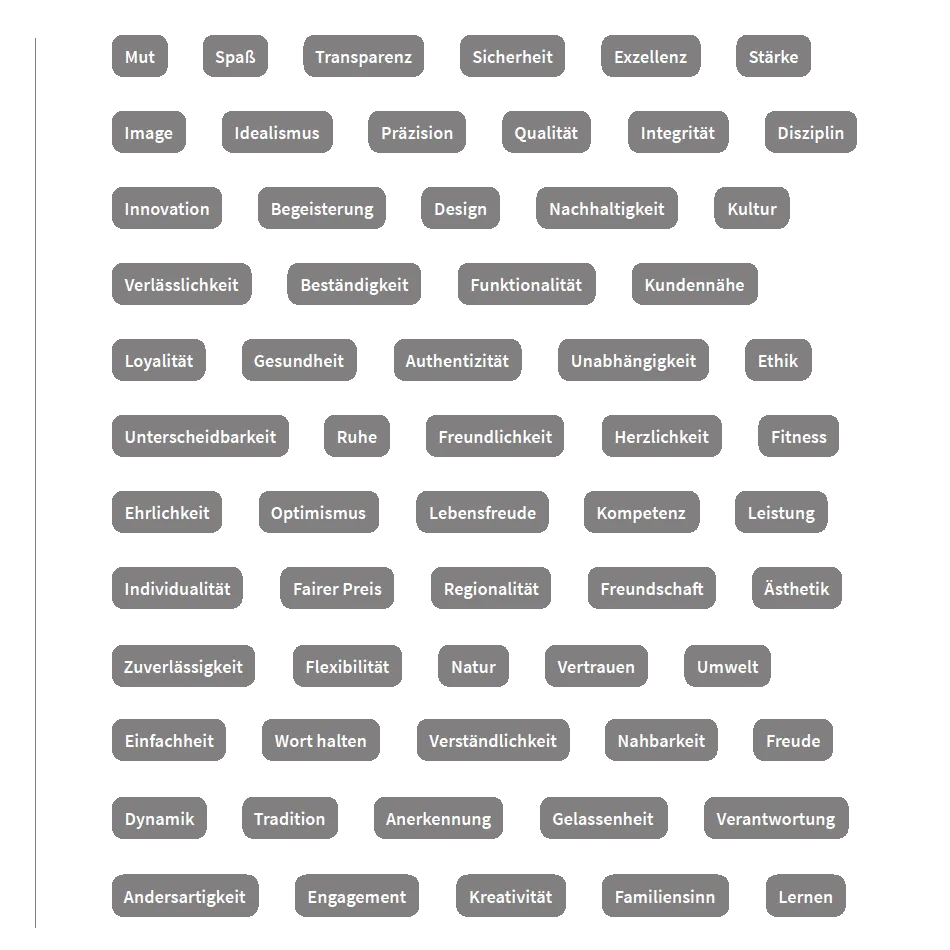In the third part of our blog series on the vision, mission and values of a brand, we explore: What is really important to your company? Get started and define your company values with the help of our tips and examples!
Every person has special values that show what they stand for and what they are valued for. It's no different for companies. The values define what is really important to the company. This includes how it operates and how it treats its employees, how it designs its products and how it communicates with customers.
Values influence your potential employees' decision for or against you. They are the kit between you and your suppliers and partners. And they can bind customers to you or repel them. They are the course book with which you steer your ship towards the future.
Important questions for the path to your values
To define your own values , you should literally question your company and realize a few important things:
- What do customers only get from you and not from other companies? What makes yours special?
- What are your company's strengths?
- What are its core values? What makes it special at its core?
- What intrinsic values do you and your team bring to the table to be successful?
- What unique selling points characterize your competitors? What do they do better than you? Which of them does your target group trust the most?
- How popular is your current offering? Why doesn't your target group use it even more? How can you reduce potential inhibitions?
- Do you have internal problems and dependencies? For example, in relation to:
- Personnel: Do your employees remain loyal to you or do they leave?
- Competencies: Which processes are ineffective?
- Finances: Is your liquidity decreasing - for example, because more and more customers are dropping out?
- Suppliers: Can you rely on your partners?
- Do you have external problems and dependencies? For example, in relation to:
- Customers: Has their consumer behavior changed? Are you struggling with too short a customer lifetime?
- Competitors: Are you facing growing online competition?
- Market environment: Are you facing a price war?
- What are your prospects for the future? Where do you see opportunities and risks?
- What potential lies dormant and could prove to be new strengths? Which new target group can you win over? Will it really solve their problems?
- With which partners can you satisfy the needs of your customers even more specifically? What approaches are there for cooperation?
In short: What do your customers get out of the fact that you exist? Why should they use your services of all things?
The wide world of values
From precise to practical, from reliable to functional - there are many different values. But which ones define your company? We have put together a few examples of values for you here - which you are welcome to add to and adapt to your industry:

Now it's your turn: firstly, choose 20 of the values for your company. Secondly, choose the 3 core values for your company from the 20 values. Important: Stay authentic and credible! Don't describe an ideal that doesn't exist in real life!
8 questions about the perception of your brand
Have you already gotten to the bottom of your company's values? Good. Now you can test their impact. How are your brand and your values actually perceived internally and externally? The answers to the following questions can help you:
- What do your employees understand by your company values?
- How can your entire company bring these values to life?
- Which of your customers' problems do you solve better than the competition?
- What special extras do you offer your customers?
- What things are your customers most happy about? It's the little things that count here.
- What feeling do you want to trigger in the viewer of your website or your brand?
- Are you currently creating this feeling with your visual and textual target group approach? Is your positioning in communication, marketing and sales clear and visible?
- Does your brand tell a story? If so, which one? Does your target group recognize itself in it with all its wishes, problems, values and challenges?
Our book tip on the subject: "MY LOVE BRAND: How to turn customers and employees into your best brand ambassadors"(e.g. on Amazon). A wonderful source of knowledge on the subject. Incidentally, these questions - adapted and expanded - are also taken from the book.
Example: How our values are reflected in communication
Values are the character of your company. To be perceived as credible and authentic, they need to be visible not only in the big message, but also in the small joys and pitfalls of everyday life - for example, when one of your customers drops out. How would you react to something like that? It was like that at our agency 4eck Media:
One of our long-standing clients got a proper growth spurt. It had more employees and more branches than before. He was now the number one in the region - and he wanted to emphasize this with a newly developed website.
We had just completed a successful website relaunch for one of its market competitors with www.mediteam-waren.de. So we had to outdo ourselves for the new number 1.
We agreed that we would outline a new concept for the website with a value-oriented approach. Our client received a PDF document with which we brought them on board to reposition and sharpen the corporate brand.
We then developed the website concept, which clarified the new value-oriented approach in terms of both structure and content. We placed a special focus on certain problems of the target group and how they can be addressed in a user-friendly way with checklists, downloads, etc.
Now there is a well-known problem for agencies: long-standing customers are used to the prices of previous orders. For example, they still have the invoice from our last joint website implementation in their heads - a fixed anchor.
However, today's websites are much more complex to develop than their predecessors. For example, they are fully responsive, meet the highest security standards, are optimized for on-page and page speed and, of course, GDPR-compliant. As they take a lot more time, they also cost a lot more money.
The end of the story: although we had hit the nail on the head with our concept, the customer asked for a comparative offer. It was clear that this would be cheaper than our offer, as our competitor no longer had to do all our preparatory work.
So we received a rejection by email - which was pretty disappointing. In our opinion, after all the free preparatory work, we at least deserved a meeting in which we could have presented our offer in person. After all, we had worked successfully with our client for five years.
Of course, we could have put our disappointment in a sharp reply email. But would that be in keeping with our values as a company? Instead, we wrote:
Hello Mr. Whatever,
Thank you for the information. It's good that you've made a decision ... unfortunately not for us. But it still suits us. Even if we would have liked to realize the order for you according to the outlined concept, we believe that it is also advantageous for customers to have new experiences with other providers every few years.
So we don't see this as a personal rejection, but say to ourselves that a "no" is good for something, both on your side and on ours.
Since your new agency needs your web server access data:
Username: xyz...
I will send you the password via Facebook as a direct message later this morning. Please change the passwords/accesses promptly ... from the server and also from the existing WordPress system. We want to avoid an unresolved situation in the event of any problems as to who still had access to the systems.
If you need agency services via 4eck Media in the future, please get in touch. We are here for you. :-)
Best regards
As you can see, even confirming a rejection is an opportunity to position yourself as a professional service provider that doesn't leave the customer with a bad feeling and keeps the door open for possible future collaboration.
The following applies: even the smallest email is a brand message that must be communicated by every employee on all channels in the interests of the company.
Otherwise, you might end up like a construction company from our region that was supposed to build a house for one of our employees and his wife 10 years ago. They had obtained 2 offers in advance. Once they had made their decision, they phoned one of the companies to cancel. Their representative reacted to the rejection like this: "Well, thank you for letting me work overtime to completely plan a house for you."
He told us the story again and again, and the construction company remained a bad memory for us. Probably none of us would have ordered a house from this company. Nor would his wife, from whom our employee divorced years later - and who now had a new house built by another company.
Incidentally, the example mentioned above with the long-standing customer and his rejection can of course also work quite differently, as MeckCura shows. We had already been looking after the company for 5 years - and in this case we were also awarded the contract for the website relaunch(you can find the full story in our 4eck Media blog).
It's simply part of everyday business life that things sometimes go one way and sometimes the other. But one way or the other, the company's values should be upheld in the event of acceptances and especially rejections. Because who knows? After a rejection, the tide could turn back in favor of acceptance with the next job.
The time is ripe for your own values
Vision, mission and values - now you have the knowledge foundation for these three important pillars of corporate success. Define them carefully for your brand. Once they are in place, you can derive not only your corporate design from them, but also your entire corporate behavior - in other words, your complete appearance as a company. In part 4 of our blog series, we reveal how you can find your vision, mission and values using a simple but very successful tool.
Other parts of the Vision, mission and values blog series
- Part 1: The vision - where your company is going
- Part 2: The mission - why does your brand exist?
- Part 3: Values - what beliefs do you represent with your company?
- Part 4: The Golden Circle - with PDF template for developing your brand mission statement

